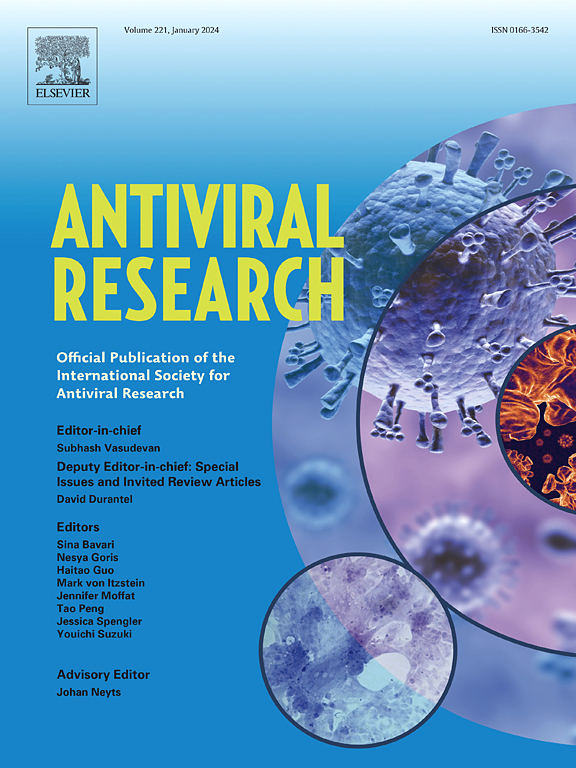Replication capacity and susceptibility of nirmatrelvir-resistant mutants to next-generation Mpro inhibitors in a SARS-CoV-2 replicon system
IF 4
2区 医学
Q1 PHARMACOLOGY & PHARMACY
引用次数: 0
Abstract
There is an ongoing need to expand the anti-SARS-CoV-2 armamentarium to include agents capable of suppressing replication of drug-resistant mutants emerging during monotherapy with approved direct-acting antivirals. Using a subgenomic SARS-CoV-2 replicon system, we studied the RNA replication capacity of nirmatrelvir (NTV)-resistant mutants and their susceptibility to next-generation Mpro inhibitors, including ibuzatrelvir (ITV), ensitrelvir (ETV), and ML2006a4. Our findings revealed that E166V Mpro mutants reduced viral RNA replication, whereas other Mpro mutations retained or increased the replication capacity, suggesting the potential of the latter to dominate under NTV selective pressure. Except for having an advantage against E166A mutants, ITV largely showed the same mutational sensitivity as NTV. ETV was more effective than NTV against E166V mutants but less effective against S144A, E166A, and L167F mutants. ML2006a4 demonstrated the most effective suppression across most mutants (S144A, E166V, S144A + L50F, E166 A/V + L50F, L167F + L50F, and E166A + L167F + L50F). Thus, ML2006a4 represents an attractive investigational candidate against clinically relevant NTV-resistant SARS-CoV-2 mutants.
在 SARS-CoV-2 复制子系统中 Nirmatrelvir 抗性突变体的复制能力和对新一代 Mpro 抑制剂的敏感性。
目前需要扩大抗 SARS-CoV-2 的药物范围,以包括能够抑制在使用已批准的直接作用抗病毒药物进行单药治疗期间出现的耐药突变体复制的药物。我们利用亚基因组 SARS-CoV-2 复制子系统研究了耐药突变体 nirmatrelvir (NTV) 的 RNA 复制能力及其对新一代 Mpro 抑制剂(包括 ibuzatrelvir (ITV)、ensitrelvir (ETV) 和 ML2006a4)的敏感性。我们的研究结果表明,E166V Mpro 突变体降低了病毒 RNA 复制能力,而其他 Mpro 突变体则保持或提高了复制能力,这表明后者有可能在 NTV 选择性压力下占据主导地位。除了对 E166A 突变体有优势外,ITV 在很大程度上表现出与 NTV 相同的突变敏感性。ETV 对 E166V 突变体比 NTV 更有效,但对 S144A、E166A 和 L167F 突变体的效果较差。ML2006a4 对大多数突变体(S144A、E166V、S144A+L50F、E166A/V+L50F、L167F+L50F 和 E166A+L167F+L50F)的抑制效果最好。因此,ML2006a4 是一种极具吸引力的候选药物,可用于抗击临床相关的 NTV 抗性 SARS-CoV-2 突变体。
本文章由计算机程序翻译,如有差异,请以英文原文为准。
求助全文
约1分钟内获得全文
求助全文
来源期刊

Antiviral research
医学-病毒学
CiteScore
17.10
自引率
3.90%
发文量
157
审稿时长
34 days
期刊介绍:
Antiviral Research is a journal that focuses on various aspects of controlling viral infections in both humans and animals. It is a platform for publishing research reports, short communications, review articles, and commentaries. The journal covers a wide range of topics including antiviral drugs, antibodies, and host-response modifiers. These topics encompass their synthesis, in vitro and in vivo testing, as well as mechanisms of action. Additionally, the journal also publishes studies on the development of new or improved vaccines against viral infections in humans. It delves into assessing the safety of drugs and vaccines, tracking the evolution of drug or vaccine-resistant viruses, and developing effective countermeasures. Another area of interest includes the identification and validation of new drug targets. The journal further explores laboratory animal models of viral diseases, investigates the pathogenesis of viral diseases, and examines the mechanisms by which viruses avoid host immune responses.
 求助内容:
求助内容: 应助结果提醒方式:
应助结果提醒方式:


